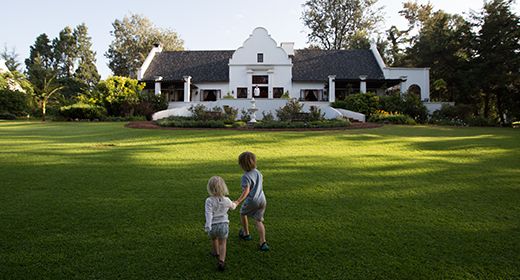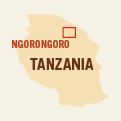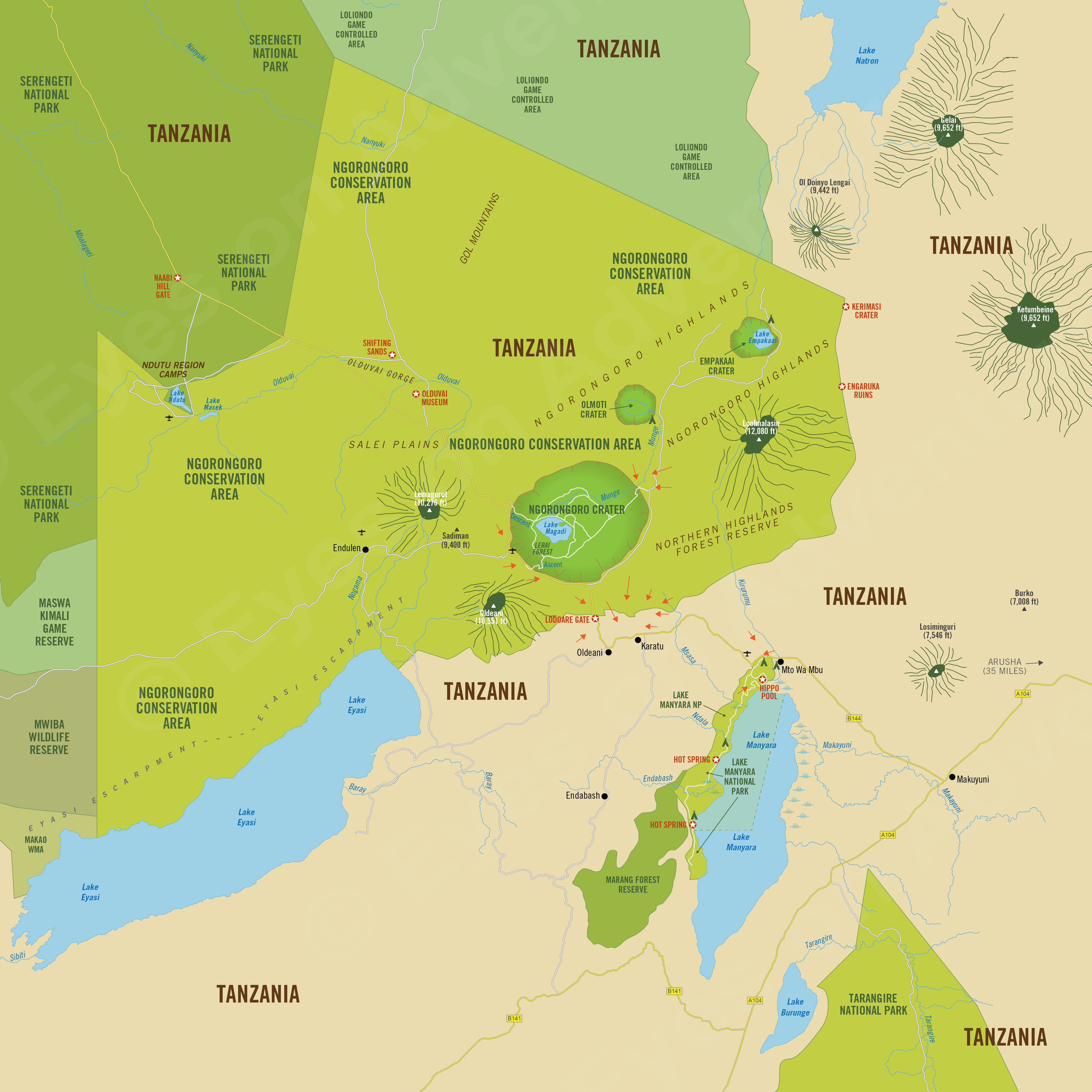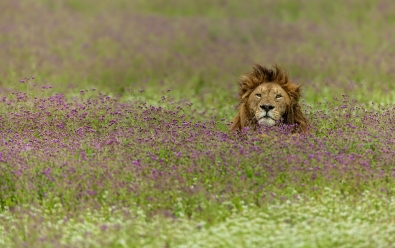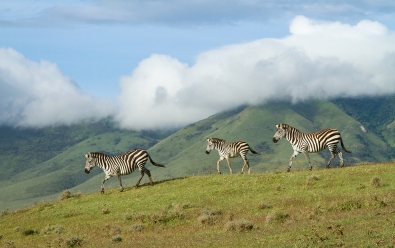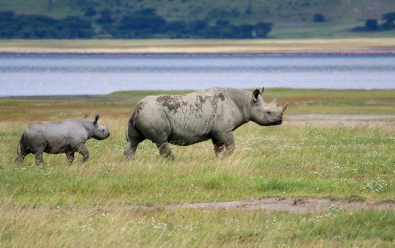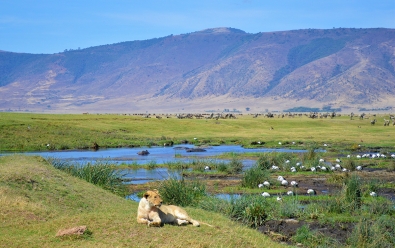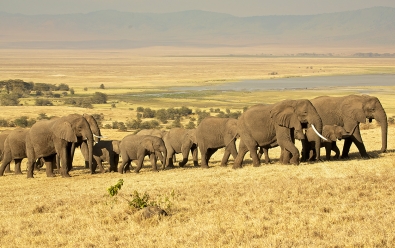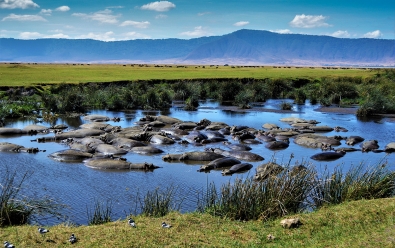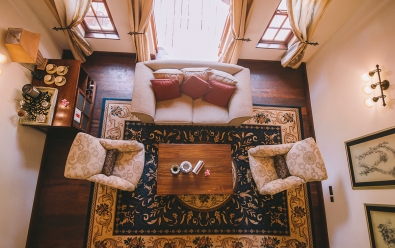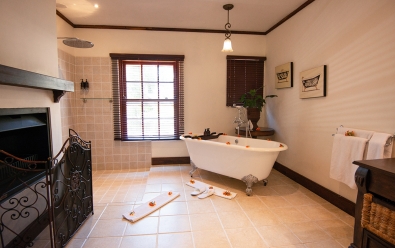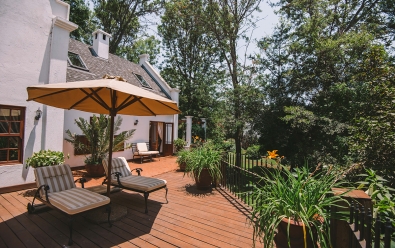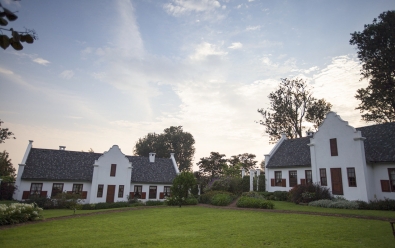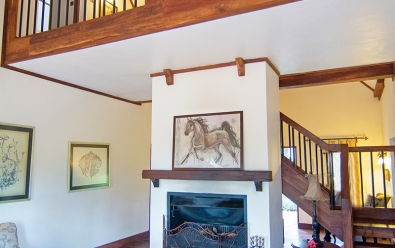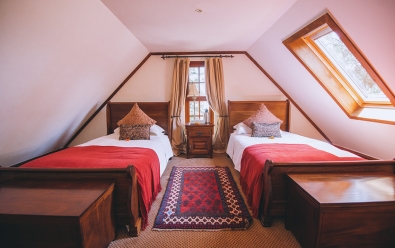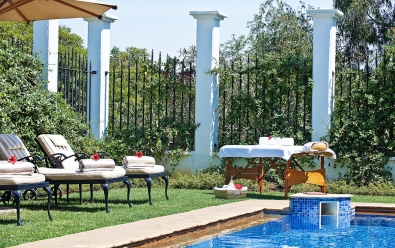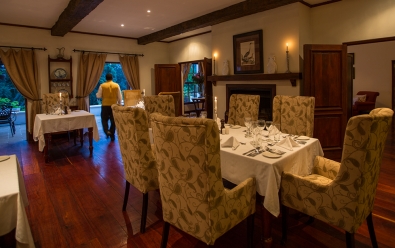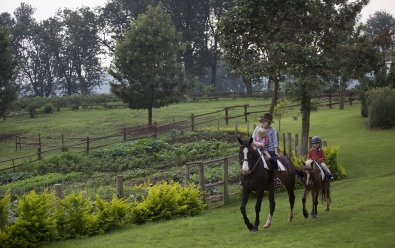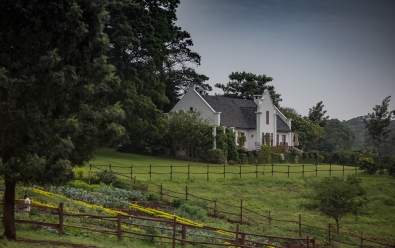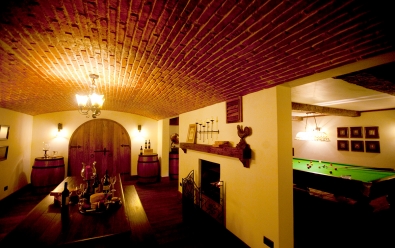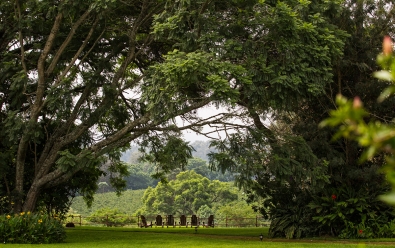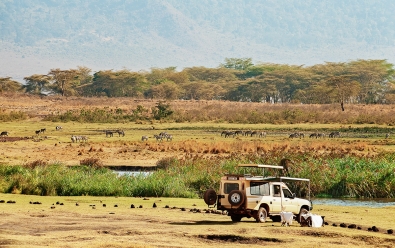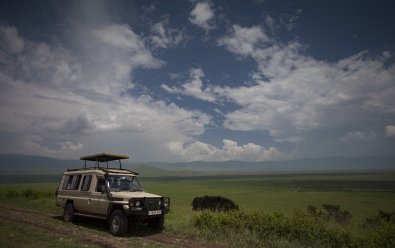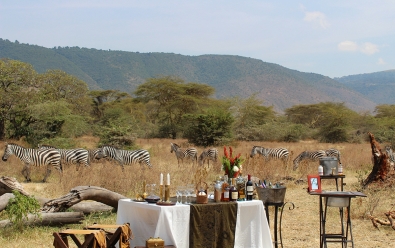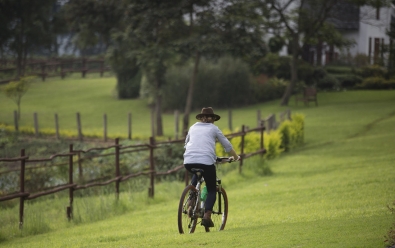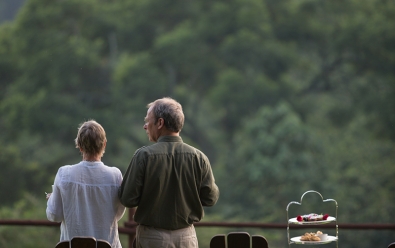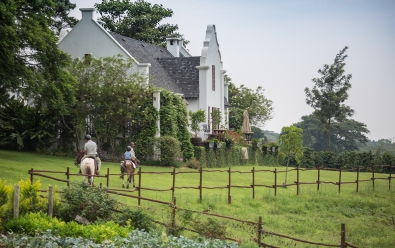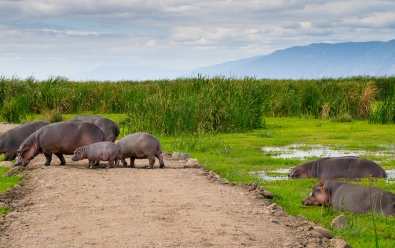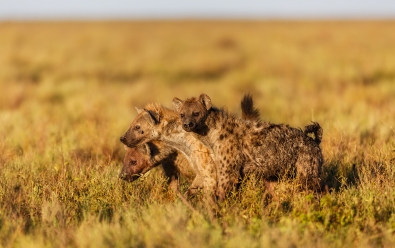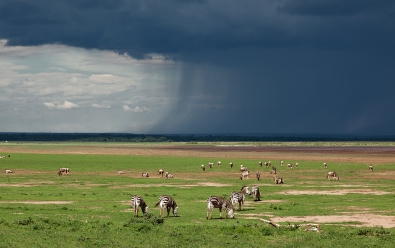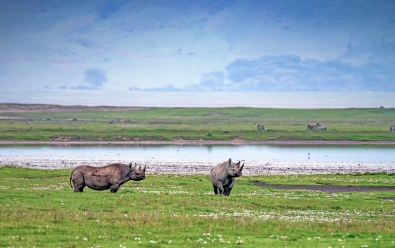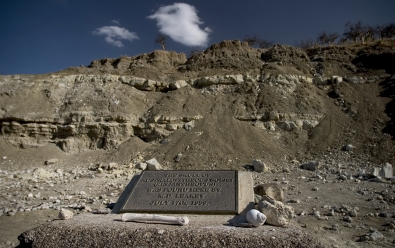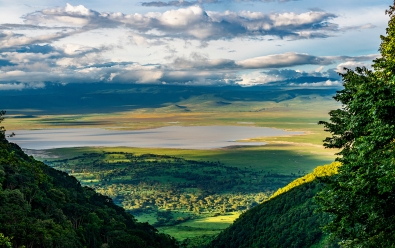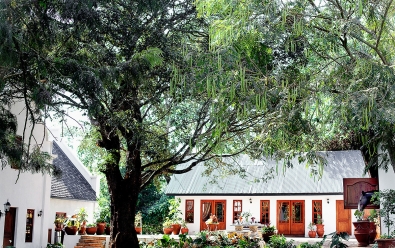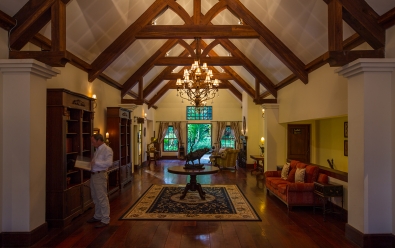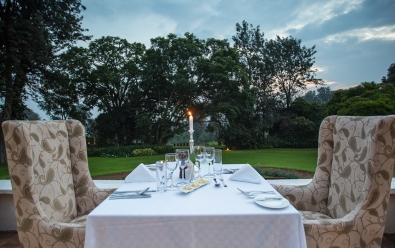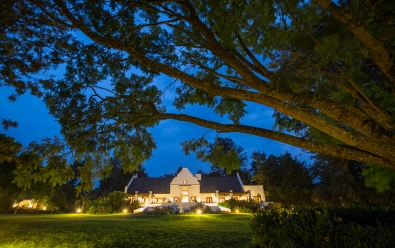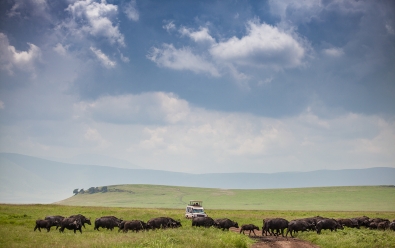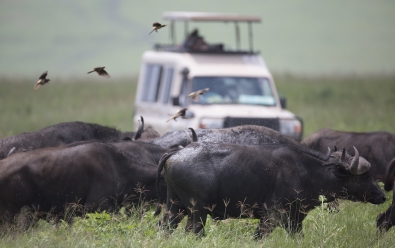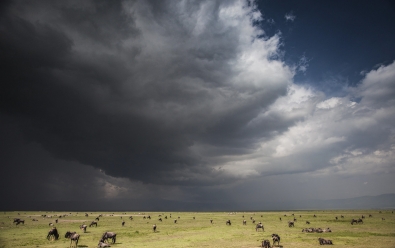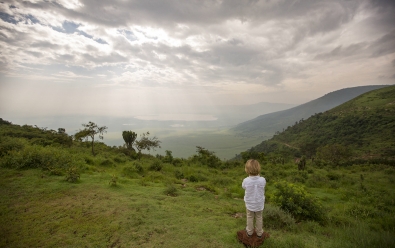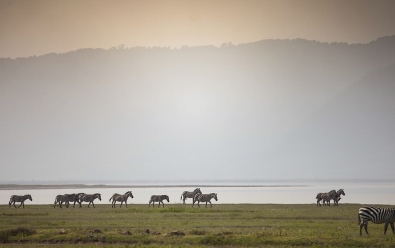The Manor at Ngorongoro
Highlights
- Ngorongoro Crater is one of Africa's prime wildlife destinations
- Elegant estate and cottages located close to The Crater
- Superb wildlife viewing in an unmatched setting
- Safaris to The Crater, Lake Manyara, horseback riding, coffee tours
Location
- 5 miles south of Ngorongoro Crater
- Ngorongoro Conservation Area
- Northern Tanzania
The Manor at Ngorongoro is a luxurious, Cape Dutch-style estate located on a colonial-era Arabica coffee plantation with lush, manicured grounds, horse stables, gardens, and romantic, old-world charm.
The estate is situated in the Ngorongoro Highlands, with easy access for safaris into the spectacular Ngorongoro Crater. The Ngorongoro Crater is the world's largest intact, non-flooded caldera and is home the around 30 000 wild animals, including all of Africa's Big Five (lion, leopard, elephant, rhino, and buffalo). Safaris inside the crater offer guaranteed wildlife around every corner and the setting itself is like nowhere else on the continent.
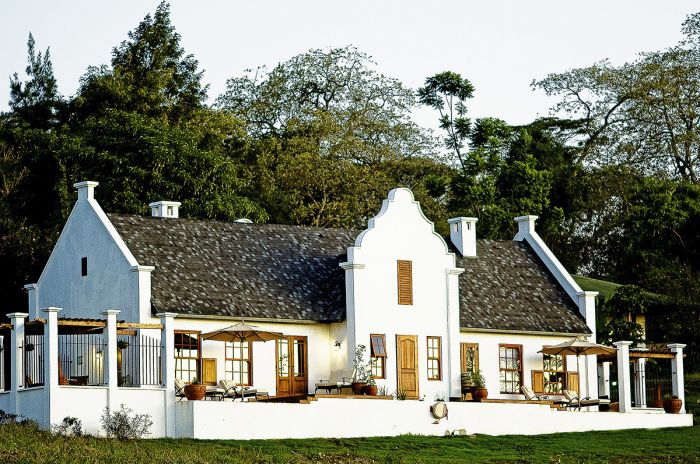
Guest cottage (two guest suites, one suite at either side) at The Manor at Ngorongoro.
Besides safaris into the Ngorongoro Crate, activities for guests at the estate include day trips into Lake Manyara National Park, explorations into the Olduvai Gorge, where archeological digs uncovered the remains of some of the earliest human ancestors, tours of the coffee plantation, horseback riding on the estate, spa treatments, croquet, birding, or simply relaxing before or after a safari in the nearby Serengeti.
The property offers 18 luxurious cottage suites, as well as a 3-bedroom cottage adjacent to the horse stables, which is ideal for a family or a group of friends traveling together.
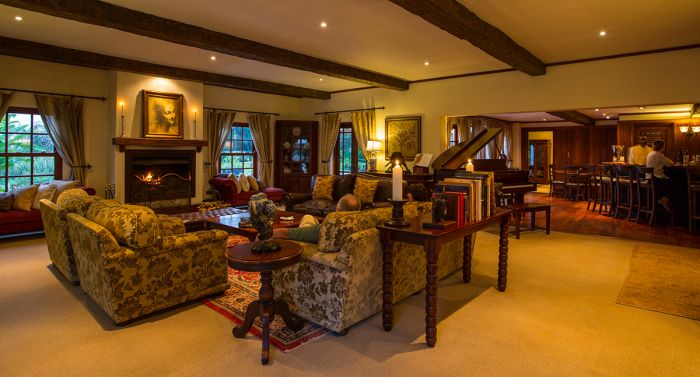
The manor house sitting room and bar at The Manor at Ngorongoro.
Like the manor house, the guest cottage suites are designed to mirror the traditional Cape Dutch architecture of the 1600s, with dark hardwood floors, white plaster walls, vaulted ceilings with exposed wood beams, and Persian rugs. The cottages include a bedroom and lounge are divided by log-burning, double-sided fireplace and the spacious bathroom has a Victorian-style, claw-footed bathtub. A lovely outdoor sun terrace can be used for private dining or just relaxing.
The Manor and guest cottages are part of a 1 500-acre coffee plantation, which guests are invited to tour. The manor's lush grounds include rolling manicured lawns, beautiful flower gardens, an herb garden, and horse stables for those who like to ride or be around horses. Children of all ages are welcome and the staff have lots of child-friendly activities for families.
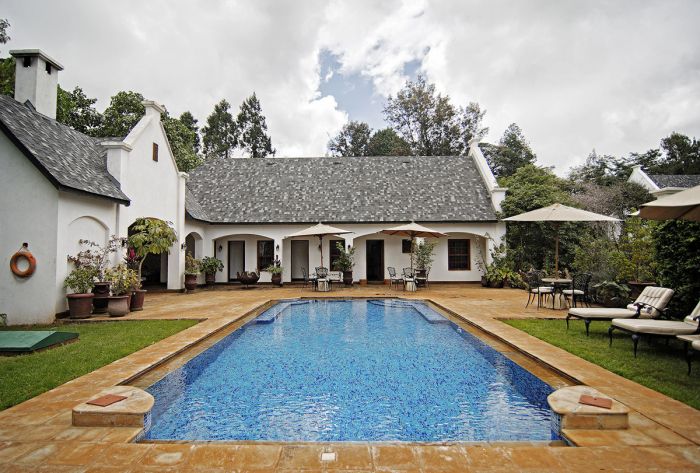
The swimming pool at The Manor at Ngorongoro.
About The Ngorongoro Conservation Area
The 3 200-square-mile (8 300-sq-km) Ngorongoro Conservation Area (NCA) is a UNESCO Biosphere Reserve (declared in 1981) and is one of Africa's most diverse regions. The NCA protects an extremely rich and diverse ecosystem that includes the volcanic highlands situated between Africa's Great Rift Valley to the east and the Serengeti Plains to the west. The Ngorongoro Crater is the highlight of the region, but there are numerous other volcanos and calderas, plus forests, plains, rivers, lakes, and fertile valleys.
The volcanic southeast portion of the NCA consists of a line of eight mostly extinct shield volcanos along the Gregory Rift Escarpment. Five of these volcanos are dome-shaped cones and three are calderas (collapsed volcanos). The Ngorongoro Crater is the largest of the calderas and is one of Africa's greatest eco-tourism destinations, with thousands of large mammals living in the crater.
Besides the Ngorongoro Crater, the NCA protects two other beautiful, albeit smaller craters: Olmoti and Empakaai. Neither can match the Ngorongoro Crater for wildlife, but both offer spectacular walking safaris into and around the craters, with almost no tourists. Both craters are easily reached from camps in the region on a day trip. The local Maasai have some small villages around these craters.
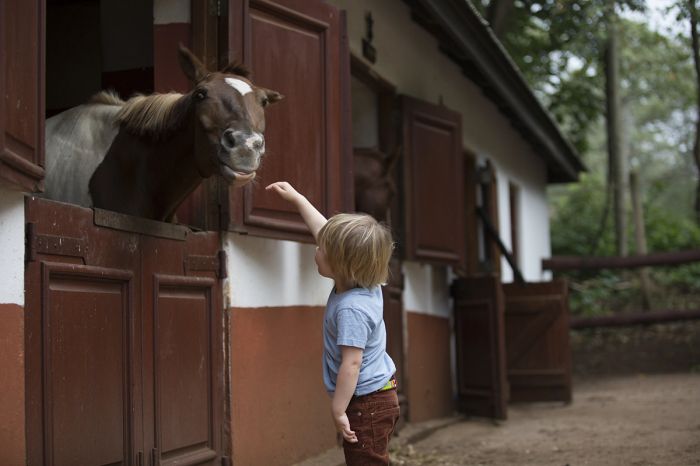
Visiting the horse stables at The Manor at Ngorongoro.
The northwest portion of the NCA adjoins with Serengeti National Park and consists of open grasslands and plains and the Gol Mountains (consisting of inselbergs). To the west of the Ngorongoro Highlands towards the Serengeti lies Olduvai Gorge, one of the most important paleo-anthropological sites on Earth, where Mary and Louis Leakey made discoveries about the earliest hominins. The nearby Salei Plains are a hotspot for the annual Great Migration of wildebeest and zebra, which move through the NCA between December and April.
The far western part of NCA includes the Lake Ndutu Area, which is a very popular destination in the southern Serengeti plains, especially when the migration of wildebeests and zebras are present in huge numbers between December and April. Some of the camps around Ndutu are located in the Serengeti National Park while others are in the NCA.
Ngorongoro is Tanzania's most visited wildlife area, attracting some 300 000 tourists from around the world each year and it is one of Africa's must-see destinations. Many safari itineraries begin in Arusha town to the east, driving west towards the Serengeti and stopping to visit Ngorongoro (and sometimes Lake Manyara) for a few days along the way.
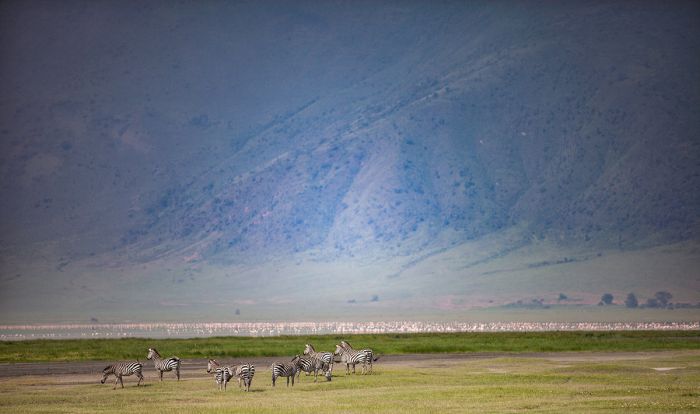
The wildlife and setting inside the Ngorongoro Crater is hard to beat.
About the NGORONGORO CRATER
The Ngorongoro Crater was formed when an enormous volcano on the western portion of Africa's Great Rift Valley erupted and collapsed upon itself some 2.5 million years ago. The violent explosion left a 2 000-foot (610-meter) deep, 12-mile (19-km) diameter crater. The crater covers an area of 108 square miles (280 sq kms), which makes it the world's largest intact and un-flooded caldera. The height of the original volcano is estimated to have been as high as 19 000 feet (5 800 meters).
Today the Ngorongoro Crater is a haven for wildlife and home to between 25 and 30 thousand large mammals, including Africa's highest density of predators. Wildlife in the Crater includes all of Africa's Big Five (lion, leopard, elephant, buffalo, rhino), providing incredible game viewing for its daily visitors. Accommodation is not allowed within the crater, so game drives descend every morning for day-long safaris in the crater and ascend to their camps, many of which are located along the crater rim, at dusk.
The steep and busy "descent road" is usually bumper-to-bumper when the morning game drives depart down into the crater at dawn. Thick mist floats through the highland forest along the rim and upper crater wall, creating an ethereal atmosphere, with birds singing and eager tourists awaiting their first exploration into the crater. The misty forest is mesmerizing in the early morning, with ancient trees, epiphytes, ferns, orchids and tree moss.
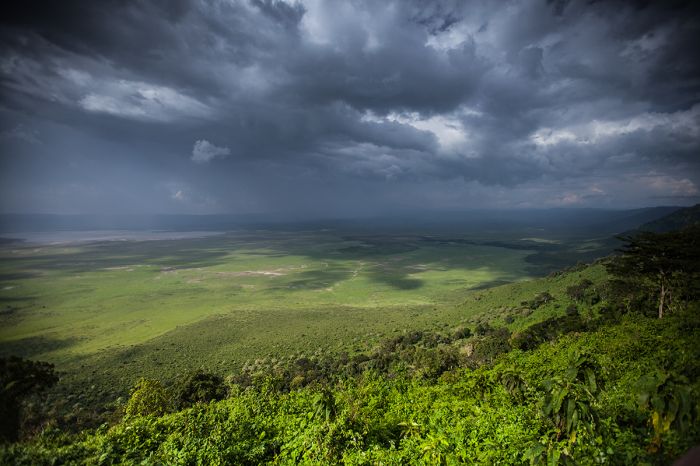
View into the Ngorongoro Crater from the rim.
The main feature on the crater floor is Lake Magadi, a shallow soda lake which size is dependent upon recent rainfall. The lake supports huge numbers of flamingos, especially during the dry season.
Wildlife in the crater is diverse and includes all of Africa's Big Five (lion, leopard, buffalo, elephant, rhino). Four of the five are a virtual guarantee on a day-long safari, with leopard being the toughest to find. Black rhinos number around twenty individuals. Lion numbers vary between 50 and 80, while the most abundant predator in the crater is the spotted hyena, which number between three and four hundred. Both golden and black-backed jackal are present in good numbers.
The lovely Lerai Forest on the southern side of Lake Magadi consists almost entirely of yellow fever tree Acacias. The forest is home to bushbuck, waterbuck, and eland. There are also several hippo pools in the crater.
Open grassland covers much of the crater floor, offering ideal habitat for grazing herbivores. Wildebeest and zebra are very common, as well as smaller numbers of buffalo, Thomson's gazelle, Grant's gazelle, hartebeest, mountain reedbuck, warthog, and topi. Elephants range throughout the crater and even climb in and out entirely. Some of the country's biggest and oldest bull elephants are full-time residents. Two species absent from the crater itself are giraffe and impala, although the occasional giraffe has been known to visit the crater, but they never stay long.
Birding in the crater is very good, with flamingos often found on Lake Magadi, as well as abundant water birds in the swamp areas. The kori bustard is commonly seen, as are ostrich and several species of vulture. Over 280 species of bird have been recorded in the crater.
Strict adherence to the crater's game drive rules are enforced and there is no off-road driving. Visitors must stay in their vehicles except at designated picnic spots.
ROOMS INCLUDES & EXCLUDES CHILDREN FACILITIES ACTIVITIES
Accommodation
19 guest accommodations in total comprising:
- 18 double-bedded cottage suites in 9 manor cottages (2 separate suites per cottage). Each suites has its own private entrance.
- 1 stable cottage accommodating a maximum of 6 guests (4 adults and 2 children). The two-level cottage has three bedrooms - two adult bedrooms on the ground floor and a children's twin-bedded room on the second floor. Each bedroom has its own en-suite bathroom (the children's bedroom has a smaller bathroom with a single wash basin and shower, but no tub). The expansive ground-floor living area includes a lounge, TV room, and dining room. The upstairs area includes the children's bedroom and a small lounge / playroom. This cottage is ideal for a family or a group of friends traveling together.
All cottage suites have spacious en-suite facilities, including a double-basin vanity, Victorian-style claw-foot tub, rain shower, and separate toilet. The cottage are connected to the main manor house by footpaths on the ground.
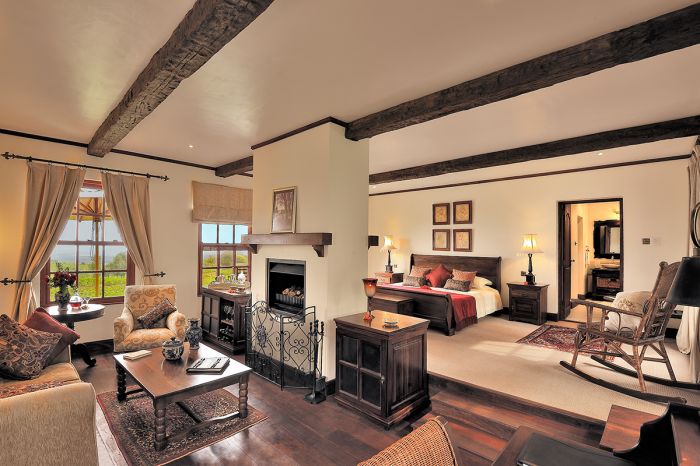
Cottage guest suite at The Manor at Ngorongoro.
The cottages are designed to mirror the traditional Cape Dutch architecture of the 1600s, with dark, hardwood floors, white plaster walls, vaulted ceilings with exposed wood beams, and Persian rugs.
Each cottage is comprised of two individual guest suites, each with its own entrance, but with an adjoining outdoor terrace. Each suite includes the bedroom, a sitting room, and a double, open-fronted, log-burning fireplace between them. The bathrooms are spacious and include a fireplace. The luxurious interiors include Victorian-style décor and furniture.
The cottage suites are spacious, covering 624 square feet (58 sq meters). The 3-bedroom stable cottage covers 1 250 square feet (116 sq meters).
Other items and features in the cottage suites include:
- Writing desk and chair.
- Lounge area with comfortable sofa and lounging chairs.
- Personal bar.
- Tea and coffee making station.
- Bathrobes and slippers.
- Hairdryer.
- Safe.
- 24-hour lighting and charging capabilities.
- WiFi available in the cottage suites and main manor house.
- Mobile phone signal available and usually reliable.
The Manor at Ngorongoro can accommodate a maximum of 42 guests in total: 2 persons in each of the 18 cottage suites, plus 6 persons in the stable cottage.
Includes & Excludes
Includes:
- All meals and local beverages including soft drinks, house wines, local brand spirits and beers, teas, and coffees.
- Safari experiences (scheduled guided game drives to the Ngorongoro Crater or Lake Manyara, horse riding on the estate, coffee tours).
- Laundry services are provided on a daily basis (weather permitting, items will be returned on the same day). Laundry is dried by the sun and on most days any laundry placed out in the morning will be returned by the evening.
- Wi-Fi access (throughout the entire camp).
- Lake Manyara Airport transfers.
- Tourism Levy & VAT.
Excludes:
- Champagne, cognacs, fine wines, premium brand spirits, and cigars.
- Additional premium activities (lunch in the Ngorongoro Crater, private estate picnic, candlelit bubble bath with sparkling wine and cheese platter, private dining experiences).
- Purchases from the Gift Shop.
- Any applicable wildlife fee, park fee, reserve fee, concession fee, other land-use fee.
Single Supplement
A single supplement may apply for any room booked by a single traveler; please ask us for pricing.
Children
Children of any age are accommodated at The Manor at Ngorongoro:
- All treehouse rooms are convertible to triples.
- Ask us about reduced rates for children sharing with adults or children 12-17 in their own suite.
- Child-friendly activities are offered.
- Children's menu available.
Some of the children's activities include:
- Swimming pool.
- Pony riding (around the property) and horse riding (around the coffee plantation for more experienced riders) for up to 1 or 2 hours.
- Satellite TV in the Cinema Room.
- ‘Little Bee’ massage treatments.
- Visit to the local farm to see the animals.
- Guided scenic / nature walks around the property with an activity book to identify animals, birds, and beetles.
- Croquet.
Facilities
The Manor is one of the most lavish properties in the Ngorongoro region, with its distinctive Cape Dutch architecture and Victorian-style furnishings. The manor and cottages are situated on one of the oldest coffee plantations in East Africa, dating back to the early British colonial period.
The grounds are such and green, with manicured lawns and beautiful gardens, and horse stables.
Main guest area facilities include:
- The main manor house, with dining room, bar, and sitting room.
- Formal dining room, dining conservatory, or room service / private dining options. Breakfast and lunch are à la carte menu and dinner is 5-course table d’hôte menu.
- Billiards room.
- Cinema / TV room.
- Spa / massage treatment facilities.
- Large swimming pool and sundeck.
- Gift Shop.
- Battery charging facilities (main manor house and guest suites).
- Complimentary Wi-Fi access.
- Mineral water is provided in the manor house and cottage suites. Guests are issued with a refillable bottle.
- The estate is connected to the national grid and has a generator for backup power.
Activities
Activities included in the rate:
- Full-day safari drives into Ngorongoro Crater in 4x4 vehicles.
- Full-day safari drives to Lake Manyara National Park.
- Excursions to Olduvai Gorge.
- Coffee tours.
- Guided nature walks on the estate property
- Horse riding on the estate.
- Croquet.
- Bush meals and sundowners.
- Birding.
- Child-friendly activities.
- All game drive vehicles fitted with inverters for battery charging on game drives.
Optional activities at additional cost:
- Private activities are on offer (subject to vehicle availability, which needs to be booked in advance).
- The Manor has special permission to host bush lunches in a private picnic area of the Crater, away from the crowds. The Crater lunch sites are subject to availability and early bookings are recommended. All Manor lunches in the Crater (regardless if in private location) are gourmet hamper affairs, under a shady awning from the side of the car, with tables and chairs.
- Massages and other spa treatments.
Great Good Fair Poor
- Jan
- Feb
- Mar
- Apr
- May
- Jun
- Jul
- Aug
- Sep
- Oct
- Nov
- Dec
GENERAL TIPS
The Ngorongoro Crater offers excellent wildlife viewing all year, as its unique ecosystem means that most of the wildlife stays in the crater throughout their lives, so the animals are in effect living in an enclosed environment.
Similar to the Serengeti region just to the west, it is advised to avoid the Ngorongoro region over March and April, when heavy rains typically occur. June to mid-October is excellent for general game viewing in the Crater in terms of the wildlife and the weather.
The Manor at Ngorongoro is open year-round. Minimum 2-night stay.
RAINS
The rainy season in northern Tanzania is from November thru mid-May, with two distinct rain seasons. The "Short Rains" (locally called the "mvuli") fall from mid-November to mid-December and are generally lighter and less impactful to safari activities. The "Long Rains" (locally called the "masika") occur between March and May, brining afternoon showers on a near daily basis.
Short Rains
The short rains occur for about one month sometime during November and December (the exact time varied somewhat year to year). This period is called the 'short' rains because the duration of an individual rain event is short and it is rare to have an all-day rain event. Most rain falls as an afternoon shower, while mornings are typically overcast or clear.
Long Rains
The long rains occur between March and May, with April being the wettest month of the year. During this time, rain should be expected almost every day and the showers can last for hours at a time, although all-day rain is not typical. The roads into and out of the Ngorongoro Crater can be quite difficult during the long rains, which can mean longer times getting in and out. Cloudy skies are typical and temperatures can be chilly at times.
The period between the short and long rains (January and February) also receives rainfall, but many days are clear and the amount and duration of the rain events is unpredictable, with some afternoon showers and the odd long and heavy shower.
TEMPERATURES
The temperatures in the Ngorongoro do not experience wide fluctuations throughout the year, as the region lies between one and three degrees south of the equator. In general, daytime temperatures are comfortably warm and overnights and early mornings are chilly. Bring a fleece and rain jacket regardless of the timing of your visit.
Ngorongoro's climate is generally mild, but temperatures in the Ngorongoro Highlands, including the camps and lodges at the Ngorongoro Crater, are heavily influenced by their higher elevations. Temperatures around the crater experience chilly to cold nights, so be prepared with appropriate attire. The Ngorongoro Crater rim (7 500 feet / 2 286 meters) and the Crater floor (5 500 feet / 1 676 meters) are at much higher elevations than the vast plains of the Ngorongoro Conservation Area to the west.
Conditions inside the Ngorongoro Crater are pleasant during the day when game drives are allowed, with temperatures averaging 68-73°F (20-23°C). Accommodations for the crater are up on the rim or further outside the caldera, where nighttime temperatures drop significantly and can approach freezing in the dry season (Jun-Oct) and average 42°F (5°C) during the rainy season (Nov-May).
THE GREAT MIGRATION
The annual movement of wildebeest and zebras across the Serengeti-Masai Mara ecosystem is one of the greatest spectacles in the natural world. These large herds move in a circular track across southern Kenya and northern Tanzania, taking a full year to complete their cycle. The migration moves across both the Greater Masai Mara (in Kenya) and the Greater Serengeti (in Tanzania) in a fairly consistent pattern and timeframe. The animals move to take advantage of fresh grasses on which to graze.
The migrating herds of roughly 1.5 million blue wildebeests and several hundred thousand plains zebras spend about nine months of the year moving through Tanzania's Greater Serengeti (which includes the Ngorongoro region) and the other three months in Kenya's Greater Masai Mara.
The migrating herds are in Tanzania's Greater Serengeti from sometime in October until around late-July (note that the timing is never precise and varies somewhat year to year). Note that the Greater Serengeti is vast, and it is important to note where in the region the herds are located during this nine-month timeframe.
The large herds of animals in the Great Migration usually cross into the Serengeti from Kenya's Masai Mara sometime around early October and move north back into Kenya around mid- to late-July.
Most of the migration stays west of the Ngorongoro Highlands, where thousands of animals move through the western portion of the Ngorongoro Conservation Area, especially around Lake Ndutu, where they spend the months of December thru April. Wildebeest calving occurs in the southern Serengeti and Ndutu area in February.
There are numerous safari camps that are set up on a seasonal basis to best see the migration throughout the Greater Serengeti, including the Lake Ndutu Area.




